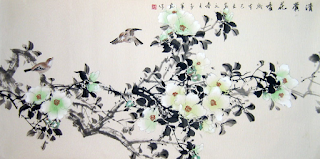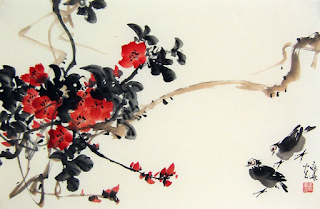As my note for this brief will include and be based around a flower that is associated and represent Chinese culture, it is important i look at using style of art associated with Chinese culture/heritage to make my note reflect this theme.
The aim of the note is the elegantly represent a collection of Chinese art styles, the modern graphic but also the older hand painted ink painting to represent Chinese culture as a whole. Taking influence from old and new in aim to make it a modern design that fits with the high technology in china now but also reflects the cultural background of the country to inform the younger generation about the past with their heritage. Its a celebration go Chinese design in all aspects to reach a large audiences this is the most populated country in the world it has a vast target market the note will need to appeal to.
RESEARCH -
https://en.wikipedia.org/wiki/Chinese_painting
Chinese painting is one of the oldest continuous artistic traditions in the world. Painting in the traditional style is known today in Chinese as guóhuà , meaning 'national' or 'native painting', as opposed to Western styles of art which became popular in China in the 20th century. Traditional painting involves essentially the same techniques as calligraphy and is done with a brush dipped in black ink or coloured pigments. As with calligraphy, the most popular materials on which paintings are made are paper and silk.
The two main techniques in Chinese painting are:
- Gongbi meaning "meticulous", uses highly detailed brushstrokes that delimits details very precisely. It is often highly coloured and usually depicts figural or narrative subjects. It is often practised by artists working for the royal court or in independent workshops.
- Ink and wash painting, in Chinese shui-mo also loosely termed watercolour or brush painting, and also known as "literati painting", as it was one of the "Four Arts" of the Chinese Scholar-official class
Chinese Flower Painting
Chinese Paint is very famous in the world. We know from textual and archaeological sources that painting was practiced in China from very early times and in a variety of media. Wall paintings were produced in great numbers in the early period of China 's history, but because so little early architecture in China remained intact over the centuries, few of these large-scale paintings have survived. Paintings were also often done on screens, which served in a sense as portable walls, but these too have not survived. From the Song dynasty onwards, paintings in a variety of other more portable formats, such as the hanging scroll and the handscroll, were collected and passed on to later generations in significant quantities. In their details of everyday life and social customs, these paintings often provide information unavailable from written texts. Many paintings are especially interesting to historians because they can help us imagine what life looked like in earlier periods. Furthermore, because paintings of this period have come to be viewed as one of the highest cultural achievements in China 's history, they provide valuable insight into aesthetic values and tastes that would have lasting impact on later artists and connoisseurs.
Chinese painting developed and was classified by theme into three genres: figures, landscapes, and birds-and-flowers.
The birds-and-flowers genre has its roots in the decorative patterns engraved on pottery and bronze ware by early artists. Among the common subjects in this genre, which reached its peak during the Song Dynasty (960 - 1279), are flowers, bamboo, birds, insects, and stones. The genre flourished under Emperor Huizong (1082 - 1135), who was an artist himself and excelled at both calligraphy and traditional painting, especially paintings of exquisite flowers and birds.
EXAMPLES-
This style of painting is a ancient Chinese style that is based around bird and flower and recording their beauty. Most of these painting are realistic so include the bright vivid colours seen at the times, the reflect the colours of the Chinese flower with added detail en feature to enhance the beauty. The paintings aren't perfect and this is as the theory says that they must reflect the buds to show the life cycle, this will be included in the back note to stay true to the cultural history and style. The detail and layout of the painting will influence the design of the note, as well as the size and shape. These follow the same pattern as most Chinese art and take the form of a the long rectangle portrait, as this is seen thought Chinese design it will be form for the note for this brief to reflect the history of Chinese art as well as the modern design form that use this style.
SHAPE OF THE NOTE SHOUDL BE LONG PORTRAIT RECTANGLE
DETAIL DRAWING THAT SHOW LIFE CYCLE AND IMPERFECTION
REALISTIC
BRIGTH COLOURS
SHOW THE BRANCHES
LONG IMAGE
OVER LAP THE BRANCHES OVER THE EGDES
START THE DESIGN INONE CONER























No comments:
Post a Comment